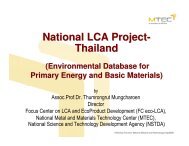ILCD Handbook: Framework and requirements for LCIA models and ...
ILCD Handbook: Framework and requirements for LCIA models and ...
ILCD Handbook: Framework and requirements for LCIA models and ...
You also want an ePaper? Increase the reach of your titles
YUMPU automatically turns print PDFs into web optimized ePapers that Google loves.
<strong>ILCD</strong> <strong>H<strong>and</strong>book</strong>: <strong>Framework</strong> <strong>and</strong> <strong>requirements</strong> <strong>for</strong> <strong>LCIA</strong> <strong>models</strong> <strong>and</strong> indicators First edition<br />
2 Development <strong>and</strong> Application of the Criteria <strong>for</strong><br />
Evaluation<br />
The development of criteria <strong>and</strong> a procedure <strong>for</strong> the evaluation of characterisation <strong>models</strong><br />
addressing midpoint <strong>and</strong> endpoint levels (Areas of Protection, AoP) is described in this<br />
section. The criteria <strong>and</strong> procedure serve to analyse existing characterisation <strong>models</strong> <strong>and</strong><br />
factors across the most common impact categories, at both midpoint <strong>and</strong> endpoint levels.<br />
The aim of this analysis is to identify the best practice among existing characterisation<br />
<strong>models</strong> <strong>for</strong> each impact category.<br />
The development of criteria builds on the work of the SETAC working groups (Udo de<br />
Haes et al., 2002) <strong>and</strong> the Life Cycle Impact Assessment programme of the UNEP-SETAC<br />
Life Cycle Initiative on the <strong>LCIA</strong> selection criteria <strong>and</strong> their application to the acidification<br />
impact category (Margni et al., 2008). This work has been modified <strong>and</strong> extended. While it<br />
integrates criteria regarding policy relevance <strong>and</strong> applicability to LCI data sets, it also covers<br />
all emission-related midpoint categories, resources <strong>and</strong> l<strong>and</strong> use, <strong>and</strong> the damage<br />
characterisation <strong>models</strong> <strong>for</strong> all Areas of Protection <strong>for</strong> damage assessment.<br />
Consultation process <strong>for</strong> development of criteria<br />
The development of criteria <strong>and</strong> their application in evaluating the methods from the<br />
different impact categories has been aided by a consultation process involving domain<br />
experts, the international cooperation of partners on good practice on LCA, including:<br />
National LCA project in Brazil, China, Japan, Malaysia, <strong>and</strong> Thail<strong>and</strong>,<br />
European Commission <strong>and</strong> EU Member-States representatives,<br />
UNEP,<br />
European Plat<strong>for</strong>m on LCA Advisory Groups, including Industry Associations <strong>and</strong> LCA<br />
research/consultancy organisations, <strong>and</strong><br />
a public stakeholder consultation.<br />
2.1 Criteria <strong>for</strong> the evaluation of characterisation<br />
<strong>models</strong><br />
The analysis of the different characterisation <strong>models</strong> relies on a set of general criteria<br />
based on fundamental <strong>requirements</strong> <strong>for</strong> <strong>LCIA</strong> methods (both characterisation <strong>models</strong> <strong>and</strong><br />
factors), which are the same <strong>for</strong> all impact categories. These consist of 5 scientific criteria<br />
<strong>and</strong> 1 stakeholder acceptance criterion.<br />
Scientific criteria:<br />
Completeness of scope<br />
Environmental relevance<br />
Scientific robustness <strong>and</strong> certainty<br />
Documentation, transparency <strong>and</strong> reproducibility<br />
Applicability<br />
2 Development <strong>and</strong> Application of the Criteria <strong>for</strong> Evaluation 7



